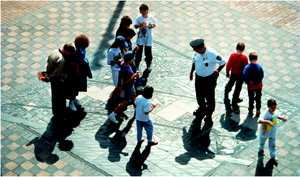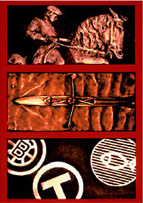Treading on History
You can learn a lot of history and literature by watching where you tread. Why? Because there are plaques offering much useful information installed in sidewalks and entrance lobbies all over the USA. For example, there's the map plaque highlighting historic buildings in Highland Park, Illinois, installed in 1984 (see photo). A set of 100 bronze panels now being set into the sidewalks of 41st Street leading towards the main New York Public Library offer quotations on literature chosen by librarians from all over the USA. was installed in 2000.


Left: This large plaque designed by Gregg LeFevre for San Francisco depicts native wildlife, roads, rivers and county lines and the epicenters of earthquakes of the last 150 years.
Right: Passers-by studying the silicon-bronze pavement map in Highland Park, Illinois, designed by Gregg LeFevre.
The great majority of these interesting plaques are made of either bronze or brass. Fewer than one in ten is made of other metals or ceramic materials, according to Gregg LeFevre, undoubtedly the most prolific of American sculptors of plaques. He has been designing plaques-over 300 to date-since 1984. His plaques are installed in 20 states plus Canada and Mexico. The largest is a 180' x 15' bronze map detailing the new Hudson-Bergen Light Rail system in New Jersey running the length of the platform at the Exchange Place station. It installed in 2000.
Copper's Durability Shines
The copper alloys are chosen by LeFevre and other creators of plaques not only for their esthetic appeal but also for their durability. Perhaps the greatest example of durability is the brass plaque (see photo) in the entrance lobby of the Solomon R. Guggenheim Museum on Fifth Avenue in Manhattan. Noting that the spiral-shaped museum was designed by Frank Lloyd Wright, widely recognized as the greatest American architect, the plaque has held up under the footsteps- entering and leaving- of nearly 40 million visitors since the museum opened in 1959. LeFevre makes those who walk on his work part of the process. As he explained, "I use foot traffic to enhance my pieces. Passersby who walk on them actually keep certain raised elements buffed and shiny."
 What a testament to the durability of copper alloys! This brass plaque at the entrance to the Guggenheim Museum on Fifth Avenue in Manhattan has been trod on as many as 80 million times by the 40 million visitors entering and exiting the museum since it opened in 1959. The quote around the periphery of the plaque is attributed to Aristophanes, whose name in Greek appears at the bottom of the plaque.
What a testament to the durability of copper alloys! This brass plaque at the entrance to the Guggenheim Museum on Fifth Avenue in Manhattan has been trod on as many as 80 million times by the 40 million visitors entering and exiting the museum since it opened in 1959. The quote around the periphery of the plaque is attributed to Aristophanes, whose name in Greek appears at the bottom of the plaque. Three of the 102 brick-shaped bronze bas-reliefs set into Winthrop Lane in Boston. Designed by Gregg LeFevre, each depicts a different aspect of the city's history and culture. The top item depicts Paul Revere's on the Charles River; and the bottom depicts popular Boston insignias.
Three of the 102 brick-shaped bronze bas-reliefs set into Winthrop Lane in Boston. Designed by Gregg LeFevre, each depicts a different aspect of the city's history and culture. The top item depicts Paul Revere's on the Charles River; and the bottom depicts popular Boston insignias.However, the raised portions can't be raised more than a quarter inch higher than the surrounding pavement, according to the Americans With Disabilities Act. Most of the plaques designed by LeFevre are cast by Matthews International, Pittsburgh. The 102 brick-shaped bronze sidewalk plaques designed by LeFevre for the city of Boston (see photo) were cast 15 years ago by a now defunct foundry in Bedford, Massachusetts.
Guggenheim Museum : 212-423-3500
LeFevre: 212-677-1445
Matthews International: 800-628-8439
Also in this Issue:
- Copper Dominates Power Generation
- Treading on History
- Copper Vital in Oceanographic Research
- Copper Powers "New Generation" Trolleys
